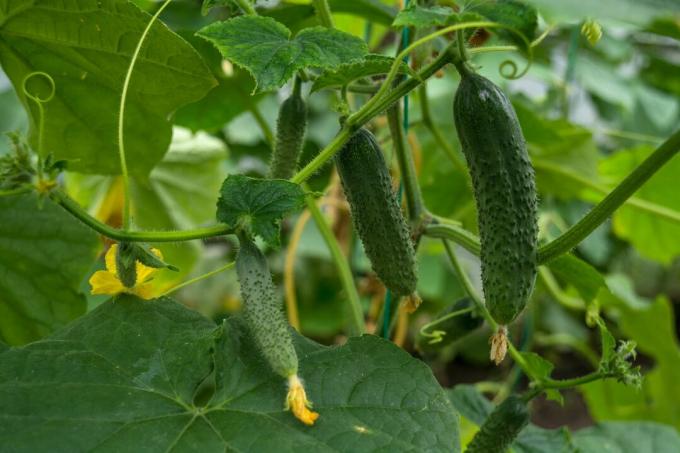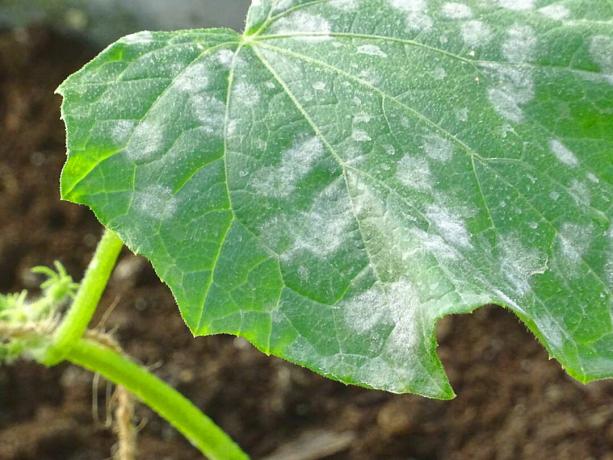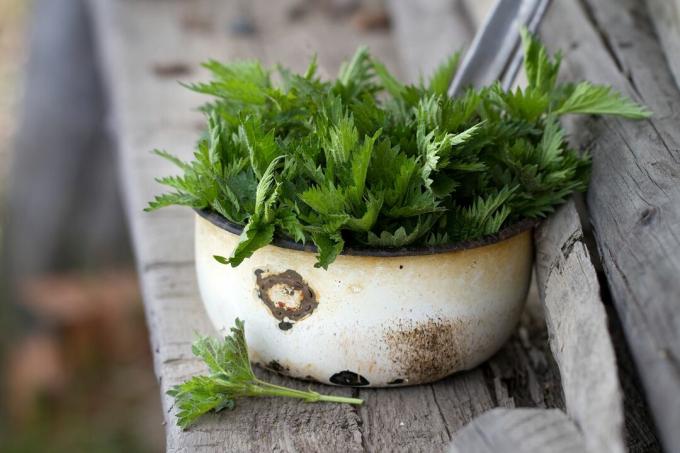Cucumbers are heavy eaters and need many nutrients for a rich harvest. We'll tell you when, how and with what best to fertilize your cucumbers.

Cucumber (Cucumis sativus) are popular summer vegetables because of their refreshing taste. They can be cultivated both in the garden bed and on the balcony. In order to thrive, the pumpkin plant (Cucurbitaceae) absolutely needs good soil. A high content of nutrients promotes the healthy growth of the cucumber and the rich set of fruits.
So when and with what should you best fertilize cucumbers? These questions are not easy to answer, because depending on the stage of growth, the cucumber plant makes very different demands on its nutrient supply. We explain what you have to pay attention to.
contents
-
When to fertilize cucumbers
- Fertilize cucumbers when sowing
- Fertilize cucumbers as young plants
- Fertilize cucumbers when planting out
- Fertilize cucumbers before harvest
-
Fertilize cucumbers: This fertilizer is best
- Organically fertilize cucumbers: instructions
- Fertilize cucumbers with minerals
- Fertilize cucumbers with home remedies: coffee grounds, horse droppings, etc.
- Fertilize the cucumbers in the pot
- Fertilize the cucumbers in the bed
When to fertilize cucumbers
The cucumber counts - as well as tomatoes (Solanum lycopersicum), Sweet peppers (Capsicum annuum) and Pumpkins (Cucurbita) - one of the strong eating vegetables. A first basic and stock fertilization should therefore be carried out when planting. During the growing season, you can compensate for the ongoing depletion of nutrients with additional fertilizers, which should be adapted to the respective developmental state of the cucumber.

Fertilize cucumbers when sowing
There are two common approaches for that Sowing cucumbers. Direct sowing outdoors can take place from mid-May when no more frosts are to be expected. For this you should already plan the floor in advance compost or enrich with rotted manure. If you want to be on the safe side, you can also pre-cultivate the frost-sensitive plants on the windowsill. To do this, from the end of April the seeds are placed in small pots with low-nutrient potting soil to promote good rooting. With good care, the resulting plants can finally be planted in the prepared garden bed from mid-May.
Fertilize cucumbers as young plants
If the effort for sowing is too great for you, you can also buy pre-cultivated young plants in the garden center. After the ice saints (mid-May), these can be planted directly in the field. Before planting out, you should also work some compost or rotted manure into the soil.
Tip from the professional: It is better to invest a little more money at the beginning and buy grafted cucumber plants. If properly cared for, these are characterized by better growth and a higher harvest.
Fertilize cucumbers when planting out
The first basic fertilization can be carried out immediately after the cucumber plants have been planted. Natural fertilizers (such as compost or manure) can work wonderfully with organic long-term fertilizers - such as our Plantura Organic tomato fertilizer - be combined. For a sufficient supply of minerals, you can also use diluted once a week during the growth and flowering phase Nettle manure to water.

Fertilize cucumbers before harvest
Cucumbers grow very quickly, so you can harvest the first fruits as early as July in outdoor cultivation. However, the cucumber plant needs plenty of nutrients for rapid growth and fruit formation. Therefore, you should re-fertilize regularly after the flowers have set. Organic fertilizer with sufficient potassium and magnesium, the cucumbers support fruit formation. Fertilization every two weeks is completely sufficient. Otherwise the plants develop a lot of leaves, but only a few fruits.
Summary: when to fertilize the cucumbers?
- Improve the soil with compost or manure before planting out
- Add organic long-term fertilizer to the planting hole when planting out
- Re-fertilize regularly (every 2 weeks)
Fertilize cucumbers: This fertilizer is best
Cucumbers should not be fertilized too much or too little. Too few nutrients lead to reduced growth and less fruit formation. However, too much nitrogen can in turn promote infestation with plant diseases. But which fertilization is the best?

Organically fertilize cucumbers: instructions
If you want to rely not only on an immediate, but also on a long-term nutrient supply, you should go for organic Slow release fertilizer To fall back on. These promote healthy, active soil life and are particularly gentle on the environment. Our Plantura organic tomato fertilizer consists for the most part of vegetable residues from the food, luxury and animal feed industries. The organic ingredients are broken down by the microorganisms in the soil and gradually release the nutrients for the plant. The high potassium content also has a particularly positive effect on the quality of the fruit. Granular fertilizers can be easily dosed and worked into the soil wonderfully. So that you optimally supply your cucumbers with nutrients, we have detailed instructions for you below.
Long-term organic fertilization: instructions and dosage amounts for cucumbers
- Before planting: 100-180 g / m² (8-15 tablespoons) of our Plantura Organic tomato fertilizer work into the upper soil layers
- Water the freshly used cucumber plants sufficiently so that the granules can dissolve well
- After 2 months you should fertilize another 90-140 g per plant (8-12 tablespoons)
- Before harvesting, you can do a little fertilization every two weeks
Fertilize cucumbers with minerals
Mineral fertilizers are particularly popular for growing cucumbers in pots, as they always guarantee a certain basic supply of nutrients. Liquid fertilizer, Blue grain and Co. are also easily soluble and can be absorbed directly by the plant. However, they are difficult to dose and the salts they contain can damage the sensitive roots if over-fertilized. Furthermore, the salts can be washed out into the groundwater and lead to increased nitrate pollution there. The high energy and raw material consumption for the production does not necessarily speak in favor of the use of chemical fertilizers.

Fertilize cucumbers with home remedies: coffee grounds, horse droppings, etc.
Natural fertilizers - for example compost or manure - can also contribute to the supply of nutrients. Soil organisms such as microorganisms, earthworms and the like are attracted to the organic material. They decompose it and at the same time loosen the soil. Cow manure or horse manure should, however, have rotted well so that the small plants do not "burn". During the growing season, you can also dilute it weekly Nettle manure Pour (in a ratio of 1:10). In this way, the cucumber is also supplied with minerals. Coffee grounds are also suitable as a natural cucumber fertilizer. In addition to potassium, it also contains plenty of nitrogen and phosphorus. As a side effect, pests like Aphids (Sternorrhyncha) scared away by the smell of coffee. The actual waste product can still be put to good use in the garden. However, too much coffee grounds should not be used for fertilization, so that the soil does not become acidic. It is best to work the coffee grounds into a mulch layer of lawn clippings, where they can be broken down gradually.

Fertilize the cucumbers in the pot
You can also easily grow cucumbers in a sufficiently large pot in the greenhouse or on the balcony. The best way to do this is to fill the pot with good compost. Compared to the garden bed, the fertilization in the pot can be better controlled. Make sure that there is an adequate supply of nutrients when planting and later during the growth and flowering phase. Regular watering also ensures that the plant does not dry out and that organic fertilizers dissolve more easily.
Fertilize the cucumbers in the bed
The soil should be provided with plenty of compost and organic fertilizer before the cucumber plants are planted. A previous green manure, sown in autumn, is also very beneficial. This loosens the soil, brings nutrients to the top layers of the soil and makes weeding easier in spring. You can then work some fertilizer into the soil regularly during the growing season. A mulch layer made from grass clippings provides additional nutrients and at the same time reduces evaporation from the soil.
Summary: how and with what fertilize the cucumbers?
- The floor with compost or improve crap
- A basic fertilization of the cucumbers when planting out with an organic slow release fertilizer such as our Plantura Organic tomato fertilizer make
- Regular top dressing supplies the plant with sufficient nutrients
- Organic slow release fertilizers promote soil life and improve the soil structure
- Coffee grounds and Herbal manure can also be used
